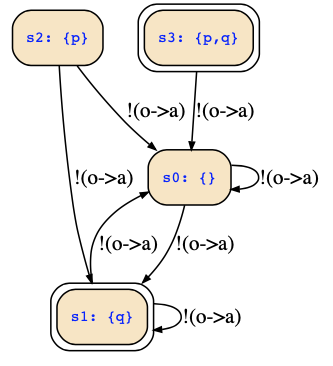To see all transitions, you would have to compute a canonical DNF, i.e., fully expanded DNF, e.g., as follows extneding your computation to a DNF:
¬(next(q)∧p∧q ∨ next(p) ∨ (o->a))
<-> ¬(next(q)∧p∧q ∨ next(p) ∨ (¬o ∨ a))
<-> (¬next(q) ∨ ¬p ∨ ¬q)∧¬next(p)∧o∧¬a
<-> ¬next(q)∧¬next(p)∧o∧¬a ∨ ¬p∧¬next(p)∧o∧¬a ∨ ¬q∧¬next(p)∧o∧¬a
<-> ¬p∧¬q∧¬a∧o∧¬next(p)∧¬next(q) ∨
¬p∧¬q∧¬a∧o∧¬next(p)∧ next(q) ∨
¬p∧ q∧¬a∧o∧¬next(p)∧¬next(q) ∨
¬p∧ q∧¬a∧o∧¬next(p)∧ next(q) ∨
p∧¬q∧¬a∧o∧¬next(p)∧ next(q) ∨
p∧¬q∧¬a∧o∧¬next(p)∧¬next(q) ∨
p∧ q∧¬a∧o∧¬next(p)∧¬next(q)
However, that is usually a lot of work and is not recommended. You can better compute the transitions as follows: With state variable p and q, we have states {},{p},{q},{p,q}. To compute their transitions, we instantiate the transition relation with their possible values:
{} : ¬(next(p) ∨ (o->a))
{p} : ¬(next(p) ∨ (o->a))
{q} : ¬(next(p) ∨ (o->a))
{p,q} : ¬(next(q) ∨ next(p) ∨ (o->a))
Now you see that states {},{p},{q} have the same transitions, namely two transitions both labeled with ¬(o->a) and leading to {} and {q}, respectively. This is so, since ¬(next(p) ∨ (o->a)) is equivalent to ¬next(p) ∧ ¬(o->a)).
The transitions of the remaining state {p,q} are given by ¬(next(q) ∨ next(p) ∨ (o->a)) which is equivalent to ¬next(q) ∧ ¬next(p) ∧ ¬(o->a), so that there is only one transition labeled with ¬(o->a) and leading to {}.
Hence, this is your FSM:
